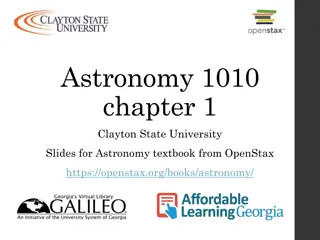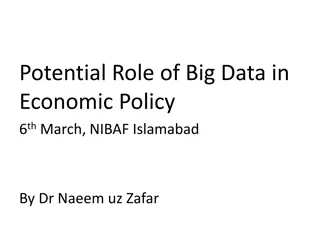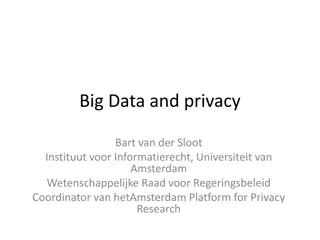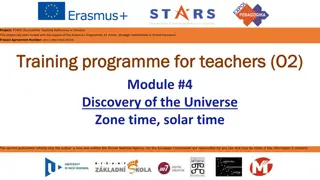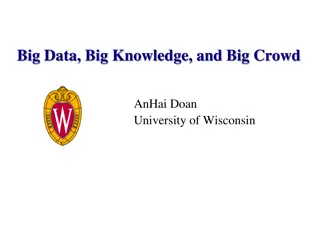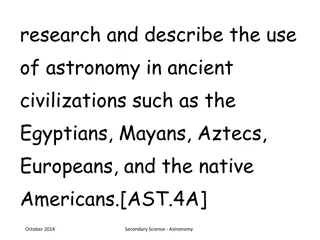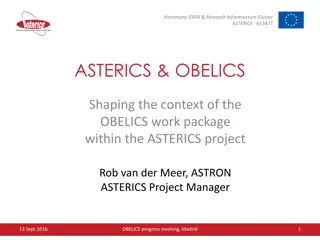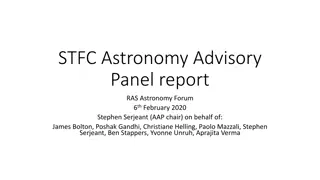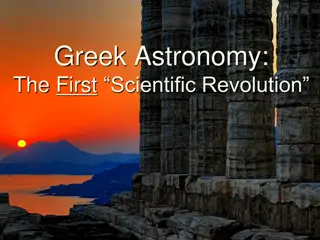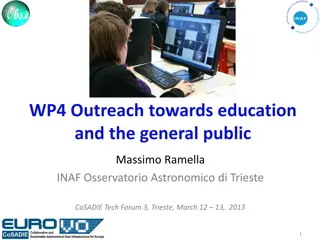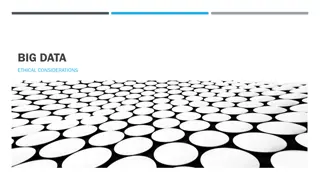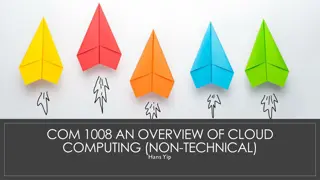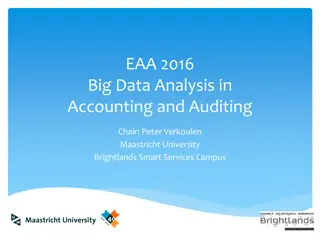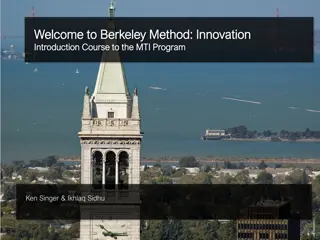Exploring Astronomy Big Data and Cyberinfrastructure for AI Innovation
Harnessing the power of big data in astronomy, this presentation by Curt Dodds from the Institute for Astronomy at the University of Hawaii, Manoa, delves into the utilization of national cyberinfrastructure to advance artificial intelligence access and foster innovation in the field. The discussion covers a range of topics including the sources of astronomy big data, from solar system bodies to galaxies and cosmological phenomena, as well as cutting-edge technologies such as the Daniel K. Inouye Solar Telescope and Spectropolarimetric Inversion in 4-Dimensions (SPIN4D). All-sky surveys like ASAS-SN, ATLAS, and Pan-STARRS play a crucial role in time-domain astronomy, enabling the study of variable stars, supernovae, and other transient events. The presentation underscores how the convergence of astronomy, big data, and AI is revolutionizing our understanding of the universe.
Download Presentation

Please find below an Image/Link to download the presentation.
The content on the website is provided AS IS for your information and personal use only. It may not be sold, licensed, or shared on other websites without obtaining consent from the author. Download presentation by click this link. If you encounter any issues during the download, it is possible that the publisher has removed the file from their server.
E N D
Presentation Transcript
Using Astronomy Big Data and National Cyberinfrastructure to Drive AI Access and Innovation Curt Dodds - Institute for Astronomy University of Hawaii, Manoa
Astronomy Big Data Sources of Big Data Observation (ground, space) Simulation Surveys Long duration time-series telescope observations Moore s Law Increased image size and dimensionality Increased simulation grid resolution and step frequency
Astronomy Big Data Solar System Sun, asteroids, comets, planets Galactic Stars Exoplanets Extragalactic Galaxies, quasars Cosmology
All Sky Surveys
All-Sky Surveys All-Sky Automated Survey for Supernovae (ASAS-SN) Asteroid Terrestrial-impact Last Alert System (ATLAS) Panoramic Survey Telescope and Rapid Response System (Pan-STARRS)
All-Sky Surveys Time-domain Astronomy Variable stars Supernovae (exploding stars) Solar flares and coronal mass ejections (CME) Object Classification Galaxy, quasar, star, asteroid, comet, supernova, variable star type Regression Estimated photometric redshift (distance from Earth)
National AI Cyberinfrastructure
National AI Cyberinfrastructure ACCESS Open Science Grid Open Science Data Federation (OSDF) / Pelican Platform National Research Platform Commercial cloud providers: EC2, GCP, Azure, etc. National AI Research Resource (NAIRR) pilot National Data Platform (NDP) National Science Data Fabric (NSDF) Campus HPC, Science DMZ, DTNs
National AI Cyberinfrastructure ACCESS Open Science Grid Open Science Data Federation (OSDF) / Pelican Platform National Research Platform Commercial cloud providers: EC2, GCP, Azure, etc. National AI Research Resource (NAIRR) pilot National Data Platform (NDP) National Science Data Fabric (NSDF) Campus HPC, Science DMZ, DTNs
National Astronomy Cyberinfrastructure
National Astronomy Data NASA archives were not designed for AI/ML Designed before the AI renaissance SQL queries with extremely limited result sizes Typically <<10Gbps bandwidth from archive sites Large N**2 crossmatch queries unsupported (but important!) Image cutout services are not performant or scalable Friction prevents researchers (grad students!) from working at scale Tools and services are fragmented and heterogeneous Some recent projects have addressed these issues in part (ASAS-SN, DKIST, LSST)
Legacy Data Access ATLAS Photometry Server Next, submit an RA and Dec coordinate to the server to obtain a URL for checking the status. Note that our request may be throttled if we make too many in a short time. Mikulski Archive for Space Telescopes (MAST) (Hubble Space Telescope, Pan-STARRS, JWST, Kepler, TESS) 3GB MyDB for query results (to query 150TB Pan-STARRS DR2 catalog) You can retrieve 0.002% of the data BY DESIGN!
Legacy Data Access Patterns Example: Download ATLAS Variable Stars from MAST https://archive.stsci.edu/hlsp/atlas-var (Heinze et al. 2018) Shard 360deg into 180x 2deg partitions each 100MB < x < 2GB Had to use trial and error to determine partition limits Manually write a download script Wait 5 days for download of 29GB of data to finish
Legacy Data Access Example: A catalog of broad morphology of Pan-STARRS galaxies based on deep Learning , Hunter Goddard (MS thesis) https://krex.k-state.edu/bitstream/handle/2097/41353/HunterGoddard2021.pdf
Driving AI Innovation
Driving AI/ML Innovation Reduce time to get started Data discovery as a service Data exploration as a service Data ready for AI/ML training Preprocessing adjacent to data origin High throughput data distribution optimized for Pytorch, Keras Transparent data caching Eliminate sources of friction
Driving AI/ML Innovation Support novel data access patterns Online training data for AI/ML on time-series Real-time data sources AI/ML inference applications Data exploration without data movement Data preprocessing without data movement Move only the data you want Transparent caching for efficiency and performance
Hawaii OSDF Data Origins Participate in OSDF/Pelican Deploy data origin service on UH/IfA DTNs Deploy data origin service on CC* HPC storage Internal outreach to researchers Who produce data Who consume data
Hawaii OSDF Data Origins IfA DTNs dtn-itc Hinode SOT SP solar observations and inversions mirror from High Altitude Observatory in Boulder, CO Critical Early DKIST Science: Spectropolarimetric Inversion in Four Dimensions with Deep Learning (SPIN4D) ATLAS-VAR variable star light curves dtn-max (Baltimore) dtn-naoj (Tokyo) dtn-hurp (Hilo, Hawaii) dtn-uk (planned - London)
Hawaii OSDF Data Origins UH CC* KoaStore data origin (new): CC* UH 800TB set aside for data federation using OSDF Datasets (work in progress) ASAS-SN - light curves for any source SPIN4D - solar photosphere simulation Hinode SOT SP - solar spectropolarimetric survey ATLAS-VAR - variable stars StePS - cosmological N-body simulation
Institute for Astronomy K8s/NRP Heterogeneous K8s cluster in Hawaii 640 CPU cores 8x L40S GPU, 2x V100GPU Federate to NRP Storage integration on-premise project storage clusters (ATLAS, ASAS-SN, SPIN4D, Pan- STARRS, H20) campus HPC Lustre storage cluster IfA DTNs
Data Services Vision: to make siloed astronomy data from Hawaii available for ML training on NAIRR, NDP, NRP, OSG and other HPC resources. Objectives: Dataset discovery service on OSDF data origin, UH DTNs Dataset discovery/exploration on OSG, NRP resources (Jupyter Notebook) Dataset streaming service on OSDF data origin, UH DTNs Dataset client streaming to OSG, NRP resources (Jupyter Notebook, PyTorch, Keras)
Extract-Transform-Distribute (ETD) ETD Data Discovery and Streaming Service is deployed adjacent to a data source using containers, (Docker, K8s). Discovery - enumerate available datasets, file exploration and access Extract - select, slice and sample from data sources Transform - process extracted examples for AI training, e.g. torch.utils.data.DataLoader and tf.data.Dataset Distribute - asynchronous parallel streaming Proof of Concept at Univ. of Hawaii using DTNs, NRP, OSDF Applications for education, training, transfer-learning, real-time inference
Resources ACCESS Open Science Grid (OSG) Open Science Data Federation (OSDF) Pelican Platform National Research Platform (NRP) National AI Research Resource (NAIRR) pilot National Data Platform (NDP) National Science Data Fabric (NSDF) Science DMZ Data Transfer Node (DTN)
Contact Information Curt Dodds Institute for Astronomy, University of Hawaii, Manoa dodds@hawaii.edu



